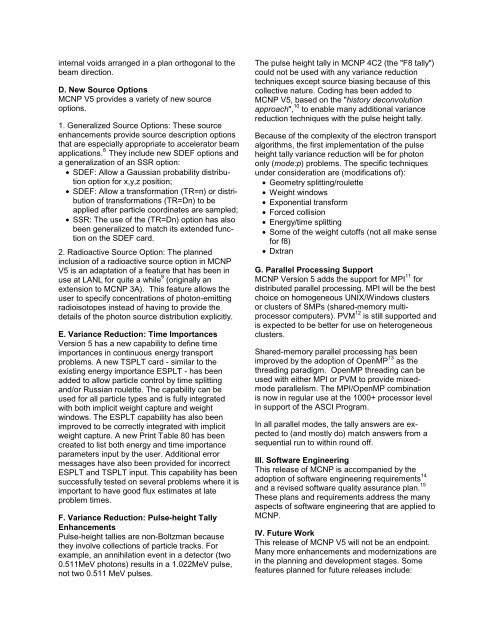MCNP• Version 5
MCNP• Version 5
MCNP• Version 5
Create successful ePaper yourself
Turn your PDF publications into a flip-book with our unique Google optimized e-Paper software.
internal voids arranged in a plan orthogonal to the<br />
beam direction.<br />
D. New Source Options<br />
MCNP V5 provides a variety of new source<br />
options.<br />
1. Generalized Source Options: These source<br />
enhancements provide source description options<br />
that are especially appropriate to accelerator beam<br />
applications. 8 They include new SDEF options and<br />
a generalization of an SSR option:<br />
• SDEF: Allow a Gaussian probability distribution<br />
option for x,y,z position;<br />
• SDEF: Allow a transformation (TR=n) or distribution<br />
of transformations (TR=Dn) to be<br />
applied after particle coordinates are sampled;<br />
• SSR: The use of the (TR=Dn) option has also<br />
been generalized to match its extended function<br />
on the SDEF card.<br />
2. Radioactive Source Option: The planned<br />
inclusion of a radioactive source option in MCNP<br />
V5 is an adaptation of a feature that has been in<br />
use at LANL for quite a while 9 (originally an<br />
extension to MCNP 3A). This feature allows the<br />
user to specify concentrations of photon-emitting<br />
radioisotopes instead of having to provide the<br />
details of the photon source distribution explicitly.<br />
E. Variance Reduction: Time Importances<br />
<strong>Version</strong> 5 has a new capability to define time<br />
importances in continuousenergy transport<br />
problems. A new TSPLT card - similar to the<br />
existing energy importance ESPLT - has been<br />
added to allow particle control by time splitting<br />
and/or Russian roulette. The capability can be<br />
used for all particle types and is fully integrated<br />
with both implicit weight capture and weight<br />
windows. The ESPLT capability has also been<br />
improved to be correctly integrated with implicit<br />
weight capture. A new Print Table 80 has been<br />
created to list both energy and time importance<br />
parameters input by the user. Additional error<br />
messages have also been provided for incorrect<br />
ESPLT and TSPLT input. This capability has been<br />
successfully tested on several problems where it is<br />
important to have good flux estimates at late<br />
problem times.<br />
F. Variance Reduction: Pulse-height Tally<br />
Enhancements<br />
Pulse-height tallies are non-Boltzman because<br />
they involve collections of particle tracks. For<br />
example, an annihilation event in a detector (two<br />
0.511MeV photons) results in a 1.022MeV pulse,<br />
not two 0.511 MeV pulses.<br />
The pulse height tally in MCNP 4C2 (the "F8 tally")<br />
could not be used with any variance reduction<br />
techniques except source biasing because of this<br />
collective nature. Coding has been added to<br />
MCNP V5, based on the "history deconvolution<br />
approach", 10 to enable many additional variance<br />
reduction techniques with the pulse height tally.<br />
Because of the complexity of the electron transport<br />
algorithms, the first implementation of the pulse<br />
height tally variance reduction will be for photon<br />
only (mode:p) problems. The specific techniques<br />
under consideration are (modifications of):<br />
• Geometry splitting/roulette<br />
• Weight windows<br />
• Exponential transform<br />
• Forced collision<br />
• Energy/time splitting<br />
• Some of the weight cutoffs (not all make sense<br />
for f8)<br />
• Dxtran<br />
G. Parallel Processing Support<br />
MCNP <strong>Version</strong> 5 adds the support for MPI 11 for<br />
distributed parallel processing. MPI will be the best<br />
choice on homogeneous UNIX/Windows clusters<br />
or clusters of SMPs (shared-memory multiprocessor<br />
computers). PVM 12 is still supported and<br />
is expected to be better for use on heterogeneous<br />
clusters.<br />
Shared-memory parallel processing has been<br />
improved by the adoption of OpenMP 13 as the<br />
threading paradigm. OpenMP threading can be<br />
used with either MPI or PVM to provide mixedmode<br />
parallelism. The MPI/OpenMP combination<br />
is now in regular use at the 1000+ processor level<br />
in support of the ASCI Program.<br />
In all parallel modes, the tally answers are expected<br />
to (and mostly do) match answers from a<br />
sequential run to within round off.<br />
III. Software Engineering<br />
This release of MCNP is accompanied by the<br />
adoption of software engineering requirements 14<br />
and a revised software quality assurance plan. 15<br />
These plans and requirements address the many<br />
aspects of software engineering that are applied to<br />
MCNP.<br />
IV. Future Work<br />
This release of MCNP V5 will not be an endpoint.<br />
Many more enhancements and modernizations are<br />
in the planning and development stages. Some<br />
features planned for future releases include:
















